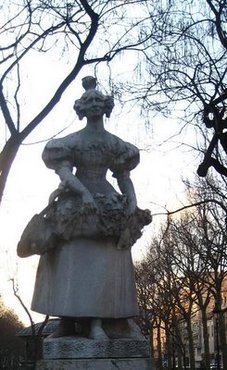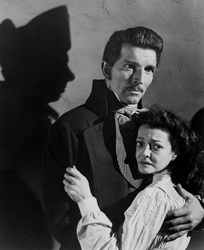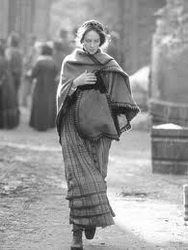Les Misérables movie adaptations: Pt.2
Fantine and the grisettes of Paris
Fantine as a Grisette
Top: Two views of the famous statue commemorating Parisian grisettes: Jules Ferry Garden in Jules Ferry Boulevard
Tom Hooper's movie focuses on Fantinethe grisette as hapless victim but in 19th Century grisettes symbolised feminine independence
The figure of Fantine has always been given prominence in movie adaptations of Hugo's novel, with the possible exception of Claude LeLouch's remarkable transpositioning of the novel to France in the first half of the 20th century. Most recent movie versions,as well as the stage musical, an overly sentimental portrayal of a vulnerable and doomed young woman. The Fantine of Hugo's novel was a grisette, which was a nineteenth century French term for a certain type of woman, and a staple character in French novels of the time, including some of Balzac's famous 'Human Comedy' series. Most movie Fantines -and certainly the stage musical version - are portrayed as waiflike, dependent on others, and naive. Yet the grisette in her various incarnations was regarded as a new type of woman: forceful, determined to demonstrate her independence and to improve her social and economic status, a hard worker, eager to use her wits and other attributes to overcome the prejudices and obstacles women faced in that century. They worked hard and partied hard, and used their dressmaking-millinery skills or contacts to make bold fashion statements -to the resentment or admiration of wealthy aristocratic and bourgeois women.
Grisettes like Fantine had certain characteristics. Crucially, they were working-class females, chiefly employed at low wages and in poor conditions in the Parisian millinery and dressmaking industries.Their name "The Little Greys" (French 'gris'= grey) derived from the grey dresses they originally wore for their job in the early 19th century. Once textile manufacturing and its offshoots had been run by many small firms; in the times of Fantine large factories and big firms were becoming dominant. They supported themselves, and sometimes their partner of the moment. What made the grisettes so interesting was their independence and initiative, although these qualities were often eroded by strenuous and unhealthy working conditions, age, disease, alcohol and often seduced and abandoned by their lovers. Some were lucky, setting up their own businesses, making a good marriage, rising into higher social ranks. The great author Honoré de Balzac used grisettes as characters in his Human Comedy novels to exspose the hypocrisies and pretensions of French society in the first half of the nineteenth century.
What novelists like Hugo and Balzac especially admired about the grisettes was their impetuosity and determination to make their own way in the world, despite their precarious economic and social position. Many either lacked or had renounced family ties. They scorned conventional views about the importance of humility, modesty and respectability for young unmarried women. And they disdained the restrictive social conventions of the time about the relationships between young men and women - not for them the conventions of chaperones, 'suitable' entertainments and delicacy. They delighted in being considered coquettish.
Instead, many grisettes adopted what would become known as a "bohemian" lifestyle, in which their leisure time often meant visits to theatres, opera and guingettes (terraced open-air cafes, frequently with dance-floors, often located on river-banks e.g. the Seine) and student bals (dances). They often had liasons with students, another socially mobile and often impecunious group. Sometimes they became the companions of artists and authors, joining them in their visits to bohemian cafes and becoming associated with the world of underground culture. Grisettes in love frequently took the initiative and responsibility in the relationship, a daring reversal of the usual norms. However, some of them accepted economic support from their male companions.
In modern jargon, grisettes tried to establish agency over their romantic and emotional commitments. Historians have recently attributed considerable significance to the emergence of grisettes - according to Alain-Marie Lescart the grisette was "an emblematic figure ...the first major step leading to our modern concept of femininity".
The Balzac Museum (Maison de Balzac) in Paris had a recent display about the lives of grisettes, aptly entitled "Elle coud, elle court, la grisette!" ("She sews, she runs, the grisette!") Although this video report on the display is in French, it contains an excellent range of visual material easily understood without any knowledge of French. Highly recommended. Click on this link: Elle coud, elle court, la grisette!
Grisettes like Fantine had certain characteristics. Crucially, they were working-class females, chiefly employed at low wages and in poor conditions in the Parisian millinery and dressmaking industries.Their name "The Little Greys" (French 'gris'= grey) derived from the grey dresses they originally wore for their job in the early 19th century. Once textile manufacturing and its offshoots had been run by many small firms; in the times of Fantine large factories and big firms were becoming dominant. They supported themselves, and sometimes their partner of the moment. What made the grisettes so interesting was their independence and initiative, although these qualities were often eroded by strenuous and unhealthy working conditions, age, disease, alcohol and often seduced and abandoned by their lovers. Some were lucky, setting up their own businesses, making a good marriage, rising into higher social ranks. The great author Honoré de Balzac used grisettes as characters in his Human Comedy novels to exspose the hypocrisies and pretensions of French society in the first half of the nineteenth century.
What novelists like Hugo and Balzac especially admired about the grisettes was their impetuosity and determination to make their own way in the world, despite their precarious economic and social position. Many either lacked or had renounced family ties. They scorned conventional views about the importance of humility, modesty and respectability for young unmarried women. And they disdained the restrictive social conventions of the time about the relationships between young men and women - not for them the conventions of chaperones, 'suitable' entertainments and delicacy. They delighted in being considered coquettish.
Instead, many grisettes adopted what would become known as a "bohemian" lifestyle, in which their leisure time often meant visits to theatres, opera and guingettes (terraced open-air cafes, frequently with dance-floors, often located on river-banks e.g. the Seine) and student bals (dances). They often had liasons with students, another socially mobile and often impecunious group. Sometimes they became the companions of artists and authors, joining them in their visits to bohemian cafes and becoming associated with the world of underground culture. Grisettes in love frequently took the initiative and responsibility in the relationship, a daring reversal of the usual norms. However, some of them accepted economic support from their male companions.
In modern jargon, grisettes tried to establish agency over their romantic and emotional commitments. Historians have recently attributed considerable significance to the emergence of grisettes - according to Alain-Marie Lescart the grisette was "an emblematic figure ...the first major step leading to our modern concept of femininity".
The Balzac Museum (Maison de Balzac) in Paris had a recent display about the lives of grisettes, aptly entitled "Elle coud, elle court, la grisette!" ("She sews, she runs, the grisette!") Although this video report on the display is in French, it contains an excellent range of visual material easily understood without any knowledge of French. Highly recommended. Click on this link: Elle coud, elle court, la grisette!
In Les Misérables, Victor Hugo gave Fantine several of the identifying features of that relatively new and significant category of young Frenchwomen. In Part One:Book 3 he introduces Fantine as one of four grisettes:
"four enchanting girls, perfumed and sparkling, something of workwomen still, since they had not wholly given up the needle, agitated by love affairs, yet preserving on their countenances a remnant of the serenity of labour, and in their souls that flower of purity.... Fantine was one of those being which had been brought forth from the heart of the people. Sprung from the most unfathomable depths of social darkness, she bore the on her brow the mark of the anonymous and unknown.... At fifteen she came to Paris to 'seek her fortune'. Fantine was beautiful and remained pure as long as she could.She was a pretty blonde with fine teeth. She had gold and pearls for her dowry; but the gold was on her head and the pearls in her mouth.
She worked to live; then, also to live, for the heart too has its hunger, she loved.She loved Tholomyes.
To him it was an amour; to her a passion. The streets of the Latin Quarter, which swarm with students and grisettes, saw the beginning of this dream. Fantine, in these labyrinths of the hill of the Pantheon, where so many ties are knotted and unloosed, long fled from Tholomyes, but in such a way as always to meet him again.....
Fantine thus fitted the image of a grisette in that she was a young,beautiful, with no family ties, who worked in the Paris clothing industry, lived in the Latin Quarter and socialised with similar young women, seeks the company of students and refuses to be bound by bourgeois ideas of respectability and discretion in relationships with males.
Yet Victor Hugo's Fantine is a grisette only in a narrow sense. She is relatively passive, not exactly feisty and essentially a victim This rather inaccurate representation continues in most movie portrayals, with the exception of Sylvia Sidney's performance, with its hints of a more stubborn and determined personality brought odwn by misjudgement and male perfidy. Hugo's Fantine is a staple of the 'Romantic' era literature: the beautiful woman deceived in love, a victim and an outcast of society, dying in poverty (frequently of tuberculosis) and degredation, a soul too good for this sordid world. It is this portrayal that we find in many movie versions and in the stage musical - a cliche apparently reiterated in Tom Hooper's 2012 film of that musical.
"four enchanting girls, perfumed and sparkling, something of workwomen still, since they had not wholly given up the needle, agitated by love affairs, yet preserving on their countenances a remnant of the serenity of labour, and in their souls that flower of purity.... Fantine was one of those being which had been brought forth from the heart of the people. Sprung from the most unfathomable depths of social darkness, she bore the on her brow the mark of the anonymous and unknown.... At fifteen she came to Paris to 'seek her fortune'. Fantine was beautiful and remained pure as long as she could.She was a pretty blonde with fine teeth. She had gold and pearls for her dowry; but the gold was on her head and the pearls in her mouth.
She worked to live; then, also to live, for the heart too has its hunger, she loved.She loved Tholomyes.
To him it was an amour; to her a passion. The streets of the Latin Quarter, which swarm with students and grisettes, saw the beginning of this dream. Fantine, in these labyrinths of the hill of the Pantheon, where so many ties are knotted and unloosed, long fled from Tholomyes, but in such a way as always to meet him again.....
Fantine thus fitted the image of a grisette in that she was a young,beautiful, with no family ties, who worked in the Paris clothing industry, lived in the Latin Quarter and socialised with similar young women, seeks the company of students and refuses to be bound by bourgeois ideas of respectability and discretion in relationships with males.
Yet Victor Hugo's Fantine is a grisette only in a narrow sense. She is relatively passive, not exactly feisty and essentially a victim This rather inaccurate representation continues in most movie portrayals, with the exception of Sylvia Sidney's performance, with its hints of a more stubborn and determined personality brought odwn by misjudgement and male perfidy. Hugo's Fantine is a staple of the 'Romantic' era literature: the beautiful woman deceived in love, a victim and an outcast of society, dying in poverty (frequently of tuberculosis) and degredation, a soul too good for this sordid world. It is this portrayal that we find in many movie versions and in the stage musical - a cliche apparently reiterated in Tom Hooper's 2012 film of that musical.
Above: three movie Fantines from the past - Sylvia Sidney (1952), the 1924-5 Bertrand movie and Uma Thurman's 1998 performance
Grisettes - some contemporary depictions
Grisettes play crucial roles in Puccini's opera La Boheme (Musetta and Mimi). Franz Lehar's operetta The Merry Widow has a grisette chorus.
|
|
|











